Chokeberry (chokeberry) is a shrub with erect stems and gray bark. In culture, chokeberry is of greatest value. In mid-April, the bushes, 1 to 2 m high, are still bare, with only the reddish tips of the leaves emerging from the brown-brown buds.
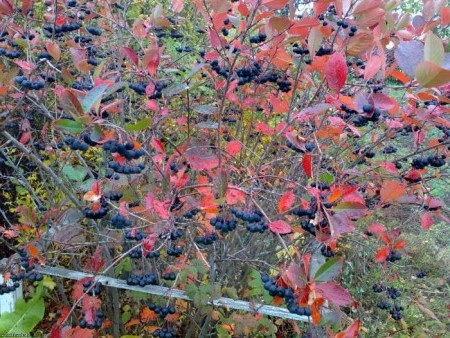
This is what chokeberry looks like
By the beginning of May, green buds are already visible among the leaves on the shortened shoots.With the establishment of warm weather, the leaves turn green and take on an oval shape on short petioles, leathery, shiny on top, serrated at the edges.
The fruits are black, shiny, juicy. They ripen in the southern regions in mid-August. The size and shape of the berries are similar to black currants. The seeds of chokeberry are very small. During the ripening period, the leaf pattern changes color. Yellowed and reddened leaves appear, which is very decorative in combination with black fruits.
Planting chokeberry
You can plant rowan in both spring and autumn, preferably in pre-prepared planting holes. If the soil on the site is bad and it is possible to bring in humus and fertile black soil, holes should be dug with a depth and a diameter of 50 cm. Fill them with the excavated soil mixed with black soil and 1-2 buckets of humus. For each pit it is good to add 200 g of superphosphate, 100 g of potassium chloride and 200-300 g of wood ash.
When planting seedlings, make a cone-shaped mound and place the seedling on it, fill the root system, lightly compact it, water it, and after absorbing the water, fill the hole to the top without watering.
In the proposed video, the cultivation of chokeberry is laid out literally on the shelves. The plant expert explains in great detail how to plant and care for chokeberries.
Technology of growing chokeberry
Chokeberry has a number of unique requirements for growing conditions. The main thing is to remember that this shrub is a light-loving crop. The bulk of flower buds are laid on the periphery of the crown. Thickened and shaded plantings significantly reduce decorativeness. When planting chokeberry in a sunny place, the distance between plants should be at least 2-2.5 m.
Caring for chokeberry.
This type of rowan is absolutely frost-resistant and does not freeze in any winter. In the first years after planting, it grows quickly, begins to bear fruit early, and from 3-4 years of age, the berry yield is stable. In favorable conditions, it blooms and bears fruit for up to 20-25 years and does not require careful care.
Due to the superficial location of the roots, it grows well in places with high groundwater levels, where fruit trees practically do not grow. Considering the structure of the root system, when caring for chokeberry, it is necessary to carry out regular watering. She loves organic fertilizing and mandatory mulching. You cannot dig up the soil under the bush; you must limit yourself to loosening it to a depth of no more than 8-10 cm.
Propagation of chokeberry.
Chokeberry has the ability to self-pollinate, so you can grow one chokeberry bush in the garden and it will still bloom and bear fruit.
Chokeberry is propagated by layering or root suckers. Independent roots on layerings and offspring are formed only in the second year, and then only under the condition of regular watering and preliminary preparation by constriction, on the border with the mother bush.
Other methods of propagation are also known - by seeds, green and lignified cuttings, but this is difficult for amateur gardeners. However, you should know that when propagated by seed, most seedlings retain the characteristics of their parents.
Crown formation.
Considering that chokeberry loves good illumination of the entire crown, when forming a bush, leave 12-15 shoots and remove the rest. First of all, you need to cut out old, broken, damaged, thin and weak shoots at the very base of the bush.
All kinds of vaccinations can be done on chokecherry. It can be grafted into the crown or onto rowan seedlings.
When harvesting, it is very important to cut or pluck rowan bushes without leaves, because the leaf at the base of the brush in its axil carries flower buds from the next year's harvest.
The berries, even when fully ripe, do not fall off and remain hanging until winter. During a dry and warm autumn, if not removed on time, they lose their juiciness and wilt. In early October, orange-yellow color predominates inside the bushes, and blood-red coloring at the ends of the branches.
Useful properties of chokeberry
What diseases are treated with chokeberry:
Chokeberry is native to eastern North America. Chokeberry is grown not only because of the high decorative value of the plant, but also for the extraordinary value of the fruit. Ripe chokeberry berries contain 2-4 times more iodine compared to other crops.
The therapeutic and prophylactic value of chokeberry is due to the high content of organic acids, tannins, sugars and vitamins. Microelements include: iron, manganese, iodine.
For preventive and therapeutic purposes, it is recommended to consume fresh, frozen, dry fruits for hypertension.
The high content of P-vitamin activity substances in chokeberry fruits makes chokeberry very useful for diabetes mellitus, kidney diseases, and allergic conditions.
Chokeberry helps reduce cholesterol in the blood of patients with atherosclerosis. It is used for gastritis with low acidity.
How to use chokeberry in landscape design
Chokeberry is perfect for decorating a garden. This plant is beautiful from early spring to late autumn.In spring, its white inflorescences stand out brightly against the background of dark green foliage.
And in the fall, the red-yellow leaves go perfectly with black, shiny berries.
Chokeberry can be grown in individual bushes or in group plantings. In addition, it makes a beautiful and practical hedge. A chokeberry hedge grows very quickly, in just 3 to 5 years. Considering that this plant propagates easily, planting material can be grown independently.
Of course, this will take extra time, but the result will be a beautiful hedge that will supply you with extremely healthy berries. In addition, caring for such a hedge is not at all difficult.
Author: L. I. Movsesyan
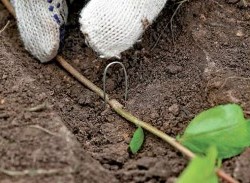
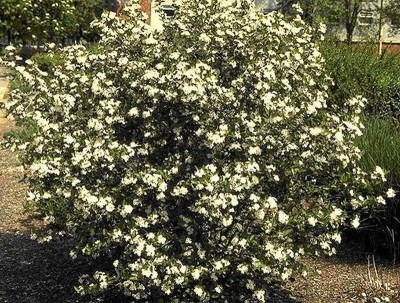
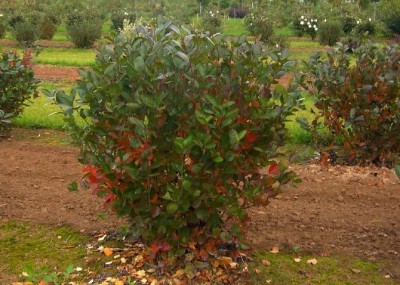
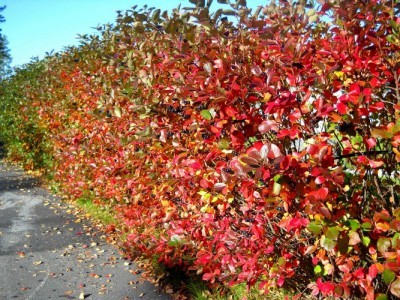

 CUCUMBERS NEVER GET SICK, I'VE BEEN USING ONLY THIS FOR 40 YEARS! I SHARE A SECRET WITH YOU, CUCUMBERS ARE LIKE THE PICTURE!
CUCUMBERS NEVER GET SICK, I'VE BEEN USING ONLY THIS FOR 40 YEARS! I SHARE A SECRET WITH YOU, CUCUMBERS ARE LIKE THE PICTURE! You can dig a bucket of potatoes from each bush. Do you think these are fairy tales? Watch the video
You can dig a bucket of potatoes from each bush. Do you think these are fairy tales? Watch the video
 How our fellow gardeners work in Korea. There is a lot to learn and just fun to watch.
How our fellow gardeners work in Korea. There is a lot to learn and just fun to watch. Eye trainer.The author claims that with daily viewing, vision is restored. They don't charge money for views.
Eye trainer.The author claims that with daily viewing, vision is restored. They don't charge money for views. A 3-ingredient cake recipe in 30 minutes is better than Napoleon. Simple and very tasty.
A 3-ingredient cake recipe in 30 minutes is better than Napoleon. Simple and very tasty. Therapeutic exercises for cervical osteochondrosis. A complete set of exercises.
Therapeutic exercises for cervical osteochondrosis. A complete set of exercises. Which indoor plants match your zodiac sign?
Which indoor plants match your zodiac sign? What about them? Excursion to German dachas.
What about them? Excursion to German dachas.